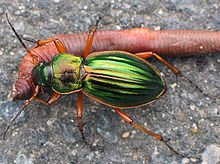Community: A group of species that occupy a given area, interacting either directly or indirectly
Predation
Consumption of one organism by another organism
- Predator-prey population oscillations
Predators and prey are agents of natural selection for each other
- defense or attack strategies
- camouflage
- aposematic colouration
Mimicry
Batesian: One species is harmful the other is non-harmful
Non-harmful evolved similar colouration so predators think its monarch
Mullerian: Both species are harmful and benefit from higher encounter rate and learning by predators
Similar colouration so predator only has to learn to avoid one thing (both bee species)
*Possibly have common ancestor to inherit similar traits or may have had a trait that was visceral and realized it had higher fitness so that trait evolved
Parasitism: One species benefits (parasite) the other is harmed (harmed) more complex, parasites smaller with shorter life spans than host
Competition
Occurs when an individual is denied resources (food, water, light, territory, space, mates)
- Exploitative – use of resources by one individual deprives others (species A use up resource before species B can use them)
- Interference – one individual prevents others access to resources (direct interaction b/w competitors)
Gause’s Experiments: Two paramecium species cannot live together but can live alone (species with the same niche cannot coexist)
Removal Experiment: Remove one species, evidence of comp. if other species expands
- Fundamental Niche: Habitat/resource use in absence of competitors
- Realized Niche: Restricted habitat/resource use in the presence of competitors (could be same size or smaller then fundamental niche, never bigger)
Character Displacement: Differences between species are exaggerated in areas of overlap (we see differences when they live together, they start using different pools of resources
Mutualism: Both species benefit from relationship
-Ex: plant pollinator, root nodules in plants
Community Structure
Species Richness: Number of species
Species Evenness: Describes how equally distributed individuals in the community are across species
Species Diversity: An index composed of richness and evenness; Intermediate Disturbance Hypothesis: Species richness greatest at intermediate disturbance
Community Dynamics
Succession: gradual changes in community structure overtime
Primary Succession: changes on a previously uninhabited environment
Secondary Succession: occurs on previously inhabited land
